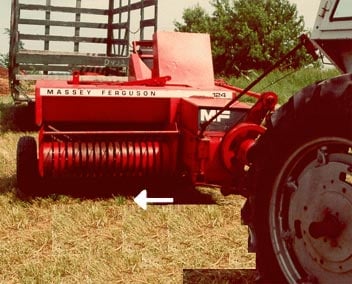Farm Worker Dies after Being Struck by a Flywheel of a Haybaler
Wisconsin FACE 99WI037
SUMMARY:
An 56-year-old male farm worker (the victim) died after being struck by a flywheel of a PTO-powered haybaler at his son’s farm. He was lying on his side under the baler, oiling a chain, while the baler was operating. A flywheel for the bale tosser cycled and struck the victim on the top of his head. The victim’s son had been working nearby, and approached the area to ask his father when the baler would be ready for field use. When the victim failed to respond, the son noted the head injury and called for help. EMS responders arrived at the scene within several minutes. The victim was pronounced dead at the scene by the medical examiner.
The FACE investigator concluded that, to prevent similar occurrences, farm equipment operators should:
- observe and follow all applicable safety precautions when operating machinery driven by tractor power take-off equipment, including disengaging the PTO and stopping the tractor engine before approaching the machinery to make repairs, adjustments or perform maintenance.
In addition, farm owners should:
- include safety management as an integral part of their business operation.
INTRODUCTION:
On June 26, 1999, an 56-year-old male farm worker died after being struck by a flywheel of a haybaler at his son’s farm. The Wisconsin FACE field investigator learned of the incident through the newspaper on June 27, 1999. The investigation was initiated on July 23, 1999, with an interview with the coroner, and followed up with a site visit, limited family interviews, and the sheriff’s report.
The victim operated a farm implement dealership, and worked part-time on his son’s crop farm. He learned farming through on-the-job training when he operated a family farm. It is unknown how he was trained for farm equipment repair. There was no written safety program for the son’s farm operation.
INVESTIGATION:
On the day of the incident, the victim was preparing a PTO-driven haybaler to help his son at the son’s farm. The baler was attached to a tractor, parked in the farmyard, while the victim performed routine oiling and inspection activities. He was using an oil spray can to lubricate the chains on the baler. The equipment design allows this task to be done from above with the machine off, and is performed routinely in this manner at the farm. He had apparently completed oiling from above, and then turned the tractor on and engaged the PTO to operate the baler. Although the event was unwitnessed, it is speculated the victim crawled partway under the baler to oil another location. He was lying on his side under the baler while it was operating. A flywheel for the bale tosser cycled and struck the victim on the top of his head. The victim’s son had been working nearby, and approached the area to ask his father when the baler would be ready for field use. When the victim failed to respond, the son noted the head injury and called for help. EMS responders arrived at the scene within several minutes. The victim was pronounced dead at the scene by the medical examiner.
CAUSE OF DEATH:
The death certificate listed the cause of death as craniocerebral trauma.
RECOMMENDATIONS/DISCUSSION
Recommendation #1: Farm equipment operators should observe and follow all applicable safety precautions when operating machinery driven by tractor power take-off equipment, including disengaging the PTO and stopping the tractor engine before approaching the machinery to make repairs, adjustments or perform maintenance.
Discussion: The chains on the hay baler in this case could be safely oiled from above while the machine was not operating. After the victim finished oiling it in the recommended manner, he apparently turned on the tractor, engaged the PTO, and went under the baler to oil another location. The incident would have have been prevented if the victim or a standby helper had observed the machine for the location of squeaking parts from a safe distance while it was operating, then disengaged the PTO and turned off the tractor before going under the baler.
Recommendation #2: Farmers should include safety management as an integral part of their business operation.
Discussion: Components of an effective safety management system include a written safety program, hazard analysis and control, training programs and safety committees. Each of these components should be developed to meet the specific needs of individual farms, and be incorporated into the farmers’ business operating plan. In this case, the incident might have been prevented if the farm developed and enforced a safety program, including a policy of observing operating machines for maintenance and repair problems from a safe distance.
REFERENCES
Safety Management on the Farm, Mark A. Purschwitz, 1996, Department Bulletin of University of Wisconsin-Madison College of Agricultural and Life Sciences, Madison, WI

Figure 1. The arrow indicates the victim’s location.
FATAL ASSESSMENT AND CONTROL EVALUATION (FACE) PROGRAM
FACE 99WI03701
Staff members of the FACE Project of the Wisconsin Division of Health, Bureau of Public Health, do FACE investigations when a work-related fatal machine-related, youth worker or road construction work-zone death is reported. The goal of these investigations is to prevent fatal work injuries in the future by studying: the working environment, the worker, the task the worker was performing, the tools the worker was using, the energy exchange resulting in fatal injury and the role of management in controlling how these factors interact.
To contact Wisconsin State FACE program personnel regarding State-based FACE reports, please use information listed on the Contact Sheet on the NIOSH FACE web site. Please contact In-house FACE program personnel regarding In-house FACE reports and to gain assistance when State-FACE program personnel cannot be reached.
